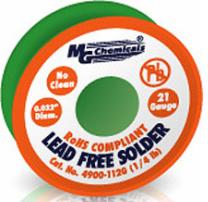Lead-Free Solder for Hobbyists
While the majority of the electronics industry has moved to lead-free solder, few hobbyists have considered the dangers of lead. Because of the Restriction of Hazardous Substances directive, or RoHS, which came to fruition in Europe in 2003, a number of substances have been restricted including lead, mercury, and cadmium.
In order to comply with the RoHS solder joints must contain less than point one percent lead. Although the RoHS is not required in the United States, it has been adopted in California and will continue to spread.
There are safety concerns and environmental considerations that make converting to lead-free solder sensible for do-it-yourselfers. The chief safety concern is lead poiso ning, which typically occurs when lead is allowed to build up over time. The biggest environmental issue with regard to leaded solder is contamination of drinking water and watersheds resulting from improper disposal.
ning, which typically occurs when lead is allowed to build up over time. The biggest environmental issue with regard to leaded solder is contamination of drinking water and watersheds resulting from improper disposal.
There are a number of lead-free solder options, but two alloys seem particularly popular: SAC305, which is made of 96.5% tin, 0.6% copper, and small amounts of nickel and silver, melts at roughly two hundred seventeen degrees Celsius; and SN100, which consists of 99.3% tin and 0.6% copper as well as some nickel and silver, melts at two hundred twenty-eight degrees Celsius. Choose whichever suits you best. Keep in mind that the higher melting point of lead-free solder makes it harder to work with than traditional solder.
After you pick an alloy you’ll need to decide on the diameter of the solder. Choosing the right diameter of solder is crucial to success, and it makes the solder easier to control. Another consideration is picking the appropriate size tip for your project. A small tip will make soldering slower, not transfer heat efficiently, and seem too cold and slow; an overly large tip can damage the circuit board, overheat and damage components, and burn off the flux too quickly. Lead-free solder is less forgiving of the wrong tip, so choosing the right size will help to prevent defects in your solder joints.
Also, be sure to use tips that are designed for lead-free solder: they will last longer than ordinary tips. Your soldering iron temperature should be between seven hundred and eight hundred degrees Fahrenheit. Never use pressure to compensate for too little wetting or poor heat transfer as this will damage the circuit board. You can optimize heat transfer by providing the best possible contact area.
